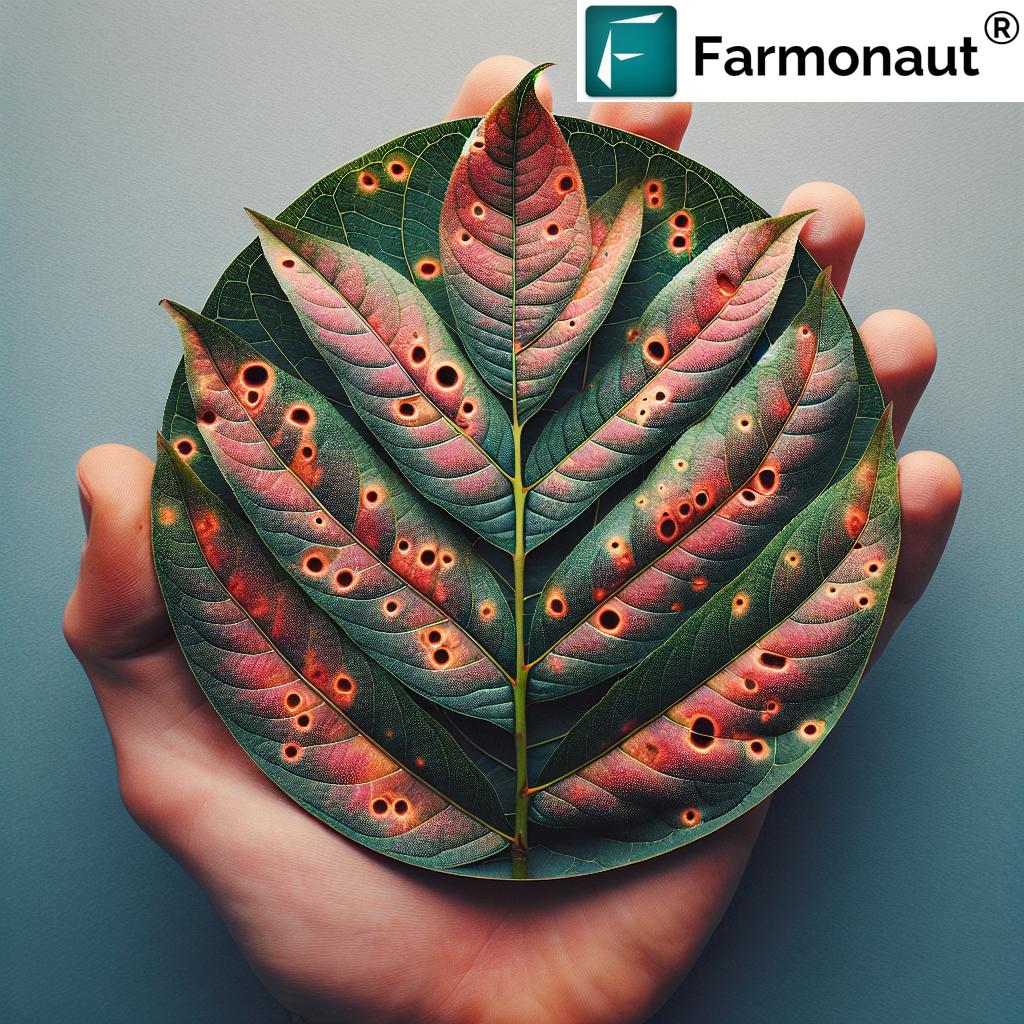Integrated Pest Management for Peach Trees: Effective Control of Diseases and Pests from Spring to Summer

As we delve into the world of peach tree cultivation, we understand the importance of protecting these delicious stone fruits from the myriad of pests and diseases that can affect them throughout the growing season. In this comprehensive guide, we’ll explore the intricacies of Integrated Pest Management (IPM) for peach trees, covering everything from early spring care to late summer harvest protection.
Understanding Peach Tree Pests and Diseases
Peach trees are susceptible to a variety of pests and diseases that can significantly impact fruit quality and yield. Some of the most common issues include:
- Fungal diseases: Brown rot, peach leaf curl, and shot hole disease
- Insect pests: Peach twig borer, Oriental fruit moth, and plum curculio
- Bacterial diseases: Bacterial spot and crown gall
Recognizing the symptoms of these problems early on is crucial for effective management. Let’s break down the pest and disease cycle by season and discuss preventative measures and treatments.
Spring: Protecting New Growth and Buds

As spring arrives, peach trees awaken from dormancy, and new buds begin to form. This is a critical time for pest and disease control.
Early Spring Tasks:
- Pruning: Remove any dead, diseased, or crossing branches to improve air circulation and reduce disease pressure.
- Sanitation: Clean up any fallen leaves, fruit mummies, or debris from around the tree to eliminate overwintering sites for pests and pathogens.
- Dormant sprays: Apply dormant oil sprays to suffocate overwintering insects and their eggs.
Peach Leaf Curl Prevention
Peach leaf curl is a fungal disease that can severely damage new growth. To prevent it:
- Apply copper-based fungicides before bud break
- Ensure complete coverage of the tree, especially the buds
- Repeat applications if rain washes off the treatment
Monitoring for Early Pest Activity
As temperatures warm, begin monitoring for signs of pest activity:
- Install pheromone traps for Oriental fruit moth and peach twig borer
- Inspect buds and young leaves for signs of feeding damage
- Look for swelling or oozing on branches, which could indicate borer activity
Late Spring to Early Summer: Protecting Developing Fruit
As fruits begin to develop, they become susceptible to various pests and diseases.
Brown Rot Management
Brown rot is a devastating fungal disease that can destroy entire crops. To manage it:
- Apply fungicides during bloom and as fruits develop
- Remove any infected blossoms or fruitlets promptly
- Maintain good orchard hygiene to reduce spore spread
Insect Pest Control
Several insect pests become active during this period:
- Peach Twig Borer:
- Monitor with pheromone traps
- Apply insecticides when trap catches indicate high populations
- Focus on timing applications to target young larvae before they bore into shoots or fruits
- Oriental Fruit Moth:
- Use degree-day models to predict moth emergence
- Apply insecticides or release beneficial insects as part of an IPM strategy
- Plum Curculio:
- Monitor for characteristic crescent-shaped scars on young fruits
- Apply appropriate insecticides when damage is first observed
Summer: Maintaining Fruit Quality and Tree Health
As summer progresses, continued vigilance is necessary to protect maturing fruits and maintain overall tree health.
Ongoing Pest and Disease Monitoring
Regular monitoring is crucial throughout the summer:
- Continue using pheromone traps to track pest populations
- Inspect leaves, fruits, and branches for signs of pest activity or disease
- Be alert for new pest introductions or unusual symptoms
Managing Late-Season Diseases
Several diseases can affect peach trees late in the season:
- Bacterial Spot:
- Look for small, dark lesions on leaves and fruits
- Apply copper-based bactericides as a preventative measure
- Improve air circulation through proper pruning
- Rhizopus Rot:
- Maintain orchard cleanliness to reduce spore populations
- Handle fruits carefully during harvest to prevent injury
- Cool harvested fruits promptly to slow fungal growth
Harvest-Time Considerations
As harvest approaches, focus on maintaining fruit quality:
- Continue monitoring for brown rot and apply fungicides if necessary
- Implement bird deterrent strategies to protect ripening fruits
- Plan harvest timing carefully to minimize pest damage and maximize fruit quality
Integrated Pest Management: A Holistic Approach
Integrated Pest Management (IPM) is a comprehensive approach to pest and disease control that emphasizes prevention, monitoring, and the judicious use of control methods. Key components of an effective IPM program for peach trees include:
- Cultural Practices:
- Proper pruning and training to improve air circulation
- Adequate fertilization and irrigation to promote tree health
- Orchard sanitation to reduce pest and disease pressure
- Biological Control:
- Encouraging beneficial insects that prey on pests
- Using microbial products to control certain diseases
- Implementing cover crops to support natural enemy populations
- Chemical Control:
- Selective use of insecticides and fungicides based on monitoring data
- Rotating chemical classes to prevent resistance development
- Timing applications for maximum effectiveness and minimum environmental impact
- Monitoring and Record-Keeping:
- Regular scouting for pests, diseases, and beneficial insects
- Using pheromone traps and weather data to predict pest activity
- Maintaining detailed records to inform future management decisions
Advanced Monitoring Techniques: Farmonaut’s Satellite-Based System
At Farmonaut, we’re revolutionizing the way farmers monitor and manage their orchards. Our satellite-based monitoring system provides unprecedented insights into orchard health and pest pressure. Here’s how our system compares to traditional monitoring methods:
| Method | Frequency | Accuracy | Cost-Effectiveness |
|---|---|---|---|
| Traditional Scouting | Weekly or bi-weekly | Moderate (depends on scout expertise) | Moderate (labor-intensive) |
| Pheromone Traps | Weekly checks | High for specific pests | Moderate (requires regular maintenance) |
| Farmonaut’s Satellite Monitoring | Daily updates | High (detects early signs of stress) | High (automated and covers large areas) |
Our system offers several advantages:
- Early detection of pest infestations and disease outbreaks
- Comprehensive coverage of entire orchards
- Integration with weather data for improved forecasting
- User-friendly interface for easy interpretation of data
To learn more about how Farmonaut can improve your orchard management, visit our application page or explore our API documentation.
Sustainable Pest Management Practices
As we strive for more sustainable agriculture, it’s crucial to adopt practices that reduce reliance on chemical interventions and promote ecological balance:
- Resistant Varieties: Plant peach varieties that show resistance to common diseases in your area.
- Companion Planting: Introduce plants that repel pests or attract beneficial insects.
- Conservation Biological Control: Create habitats that support natural enemies of peach pests.
- Precision Application: Use targeted spraying techniques to minimize pesticide usage and environmental impact.
- Pheromone Disruption: Employ mating disruption techniques for key pests like Oriental fruit moth.
The Role of Technology in Modern Orchard Management
Technological advancements are transforming pest management in peach orchards. At Farmonaut, we’re at the forefront of this revolution:
- Satellite Imagery: Our high-resolution satellite data allows for early detection of stress patterns that may indicate pest or disease issues.
- AI-Powered Analysis: Our algorithms analyze spectral data to identify potential problems before they’re visible to the naked eye.
- Mobile Applications: Access real-time orchard data on-the-go with our mobile apps, available for Android and iOS.
- Weather Integration: Our Satellite Weather API provides localized forecasts to help time pest management activities effectively.
Case Studies: Successful IPM Implementation
While we don’t include specific case studies, our experience has shown that growers who adopt comprehensive IPM strategies often see significant improvements in fruit quality and yield, while reducing overall pest management costs. Key success factors include:
- Commitment to regular monitoring and record-keeping
- Willingness to adapt strategies based on changing conditions
- Integration of multiple control methods, including cultural, biological, and chemical approaches
- Continuous education on new pest management techniques and technologies
Future Trends in Peach Orchard Pest Management
Looking ahead, we anticipate several exciting developments in pest management for peach orchards:
- Precision Agriculture: Increased use of drones and sensors for targeted pest detection and treatment.
- Biopesticides: Development of new, environmentally friendly pest control products derived from natural materials.
- Genetic Engineering: Potential introduction of pest-resistant peach varieties through advanced breeding techniques.
- Artificial Intelligence: Enhanced predictive models for pest outbreaks based on historical data and real-time conditions.
- Climate Adaptation: Strategies to manage changing pest pressures due to shifting climate patterns.
Conclusion: Empowering Peach Growers with Knowledge and Technology
Effective pest and disease management in peach orchards requires a multifaceted approach that combines traditional wisdom with cutting-edge technology. By embracing Integrated Pest Management principles and leveraging advanced monitoring tools like those offered by Farmonaut, growers can protect their crops more effectively while reducing environmental impact.
Remember, successful pest management is an ongoing process that requires vigilance, adaptability, and a commitment to continuous learning. By staying informed about the latest research and technologies, and by carefully observing and responding to the unique conditions in your orchard, you can cultivate healthy, productive peach trees that yield bountiful harvests of delicious fruit.
To take your orchard management to the next level with Farmonaut’s advanced satellite monitoring system, consider subscribing to our services:
Frequently Asked Questions (FAQ)
- Q: What is the most effective way to prevent peach leaf curl?
A: The most effective prevention for peach leaf curl is applying copper-based fungicides before bud break in late winter or early spring. Ensure complete coverage of the tree, especially the buds. - Q: How often should I monitor my peach trees for pests?
A: Regular monitoring is crucial. We recommend weekly inspections during the growing season, with more frequent checks during critical periods like bloom and fruit development. - Q: Can organic methods effectively control pests in peach orchards?
A: Yes, organic methods can be effective when used as part of a comprehensive IPM strategy. These include cultural practices, biological controls, and organic-approved pesticides. - Q: How does Farmonaut’s satellite monitoring system improve pest management?
A: Our system provides daily updates on orchard health, detecting early signs of stress that may indicate pest or disease issues. This allows for more timely and targeted interventions. - Q: What are the benefits of using pheromone traps in peach orchards?
A: Pheromone traps help monitor specific pest populations, allowing growers to time control measures more accurately and reduce unnecessary pesticide applications. - Q: How can I reduce my reliance on chemical pesticides in peach production?
A: Implement a comprehensive IPM program that includes cultural practices, biological controls, and precise monitoring. Use chemical controls only when necessary based on pest thresholds. - Q: What role does proper pruning play in pest management?
A: Proper pruning improves air circulation and light penetration in the tree canopy, creating an environment less favorable for many pests and diseases. - Q: How can I protect my peaches from bird damage?
A: Effective bird deterrent strategies include netting, visual deterrents like reflective tape, and acoustic devices. The best approach often involves a combination of methods. - Q: What are the signs of peach tree borer infestation?
A: Look for oozing sap mixed with frass (insect excrement) at the base of the tree or on lower branches. You may also notice wilting or yellowing of leaves. - Q: How does climate change affect pest management in peach orchards?
A: Climate change can alter pest life cycles, introduce new pest species, and change the timing of pest outbreaks. Adaptive management strategies and robust monitoring systems like Farmonaut’s are crucial for addressing these challenges.